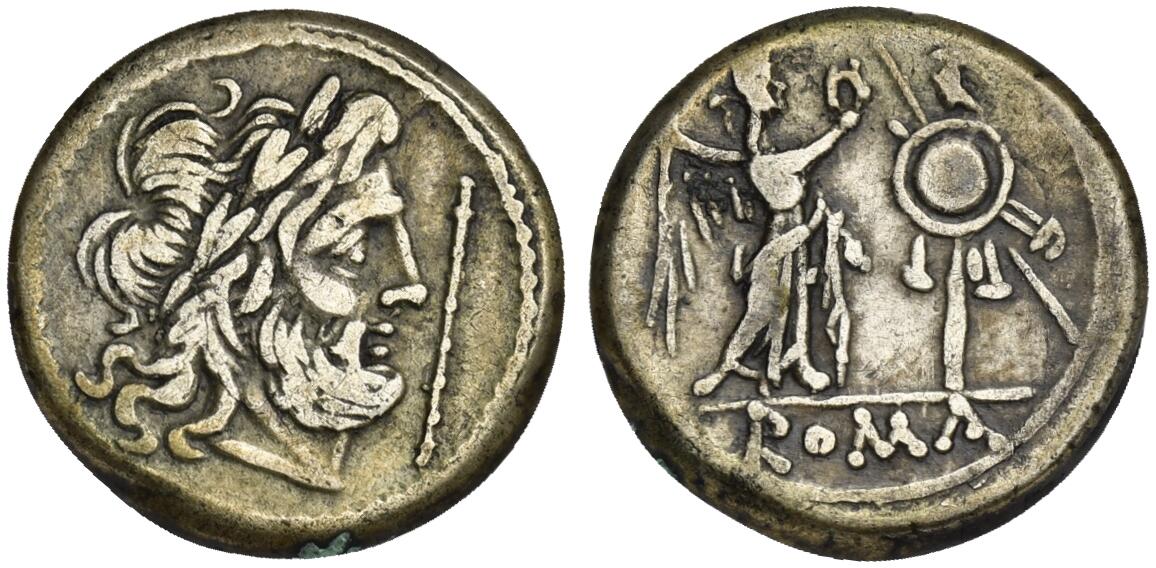Capua (Roman Republic), silver, victoriati (Jupiter/Victory crowning trophy) (RRC 112/1 - 206 BCE)
From SILVER
206 BCE - 206 BCE Silver 2,470 kg
Description
| ObverseInscription or printing placed on the obverse.: | Laureate head of Jupiter r. |
| ReverseInscription or printing placed on the reverse.: | ROMA (Latin).Victory standing r., crowning trophy |
Mint and issuing power
| MintIdentifies the place of manufacture or issue of a numismatic object.: | Capua | Ancient regionAncient region.: | Campania | Modern countryModern country: Italy | AuthorityIdentifies the issuing power. The authority can be "pretended" when the name or the portrait of X is on the coin but he/she was not the issuing power. It can also be "uncertain" when there is no mention of X on the coin but he/she was the issuing power according to the historical sources: | Roman Republic |
Chronology
| FromIdentifies the initial date in a range assigned in a numismatic context. | 206 BCE | toIdentifies the final date in a range assigned in a numismatic context.. | 206 BCE | PeriodTime period of the numismatic object.: Hellenistic 323-30 BC |
Physical description
| MetalThe physical material (usually metal) from which an object is made.: | Silver |
Median weightMedian of the weights of numismatic objects (in grams). in grams | 2.90 | DenominationTerm indicating the value of a numismatic object. Examples: tetradrachm, chalkous, denarius.: | victoriatus |
StandardStandard.: |
Image

Rome_RRC_112_1.jpg [1]
References
| Die study referencePublication of the study: | Debernardi 20241Debernardi 2024 | ||
| Coin series referenceReference to coin series study: | Sydenham 19522Sydenham 1952, n° 242, RRC3RRC, n° 112/1 | ||
| Coin series web referenceCoin series web references: | |||
Obverse dies distribution
no distribution is available
Reverse dies distribution
no distribution is available
Quantification
| Number of obversesNumber of obverse dies. ᵖ (o) | 28 | Number of singletons (o1)The number of singleton coins. ᵖ | 15 |
| Number of reverse diesNumber of reverse dies. (r) | 41 | Number of coinsNumber of coins. (n) | 61 |
| Coins per obverse dieNumber of coins per obverse die. (n/o) | 2.18 | Coins per reverse dieNumber of coins per reverse die. (n/r) | 1.49 |
| Reverse per obverse ratioRatio of obverse dies divided by reverse dies. (r/o) | 1.46 | Percentage of singletons (o1)number of coins (n) divided by the number of singletons (o1) ᵖ | 53.57 % |
| Original number of dies (O) (Carter 1983 formula)The estimation of the number of coins according to Carter 1983 ᵖ | 42.58 | Coins struck if 20,000 as average productivity per dieCoins made if the average productivity for obverses (according to Carter) is 20,000. ᵖ | 851,600 |
| Original number of dies (O) (Esty 2011 formula)The estimation of the number of coins according to the singleton formula in Esty 2011 ᵖ (O) | 51.76 | Survival rate if 20,000 as average productivity per dieSurvival rate if average productivity is 20,000. ᵖ | 0.00007 |
| Coverage (o = % of O) (Esty 1984 formula)Esty 1984 - coverage (% of O) ᵖ (o = % of O) | 75.41% | Die productivity if survival rate 1/2,000Average productivity if survival rate is 1/2,000. ᵖ | 2,865.19 |
| Weight of silver (in kg) if 20,000 coins per die (O = Carter formula)Carter 1983 * Median weight * 20000 (*10 if gold or electrum) ᵖ | 2,470 kg <br /> 2,470 kg | Die productivity if survival rate 1/5,000Average productivity if survival rate is 1/5,000. ᵖ | 7,162.99 |
Remarks
Certainly military
References
- ^ Debernardi, Pierluigi (2024), RRSC. Roman Republican Silver Coins. Volume I: Beginnings - 200 B.C., San Marino, Artemide Aste, 320 p.
- ^ Sydenham, Edward Allen (1952), The Coinage of the Roman Republic, London, Spink & Son Ltd., lxix, 343 p., 30 pl.
- ^ Crawford, Michael H. (1974), Roman Republican Coinage, Cambridge